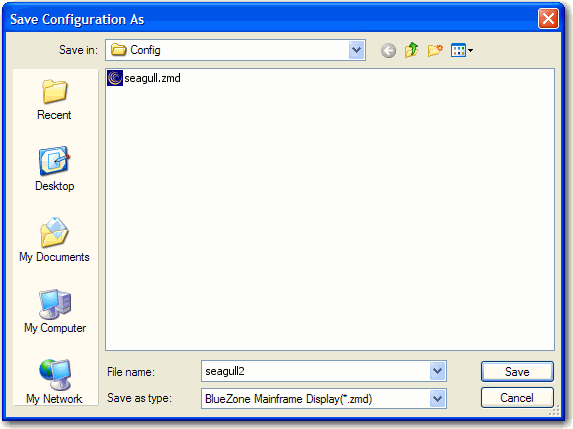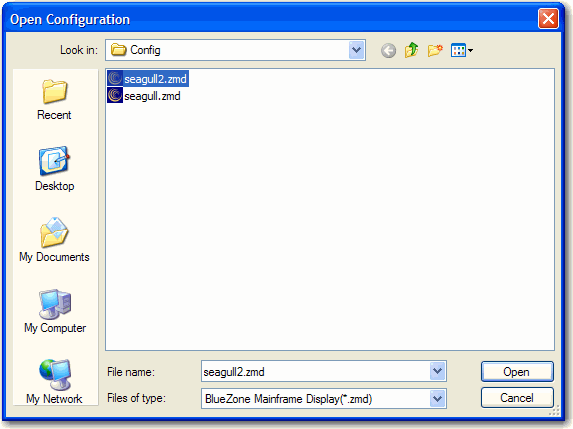 SEE
The BlueZone Configuration File Extension Table
in Appendix C for a complete list
of BlueZone Configuration File extensions.
SEE
The BlueZone Configuration File Extension Table
in Appendix C for a complete list
of BlueZone Configuration File extensions.|
Configuring BlueZone |
Chapter 5 |
Topic Quick Links:
Starting BlueZone Sessions - All Modes
Saving BlueZone Session Configurations to the Registry - Registry Mode
Opening BlueZone Session Configurations from the Registry - Registry Mode
Saving BlueZone Configurations to a File - Registry Mode
Automatically Loading Configuration Files - Registry Mode
BlueZone sessions may be started several ways; using the BlueZone Session Manager, as described in the previous chapter; using the BlueZone Desktop icons created during installation; using the Auto-Launch session feature found on the Auto–Launch tab in File:Properties; or from a Command Prompt using a Command Line Switch.
Each of these methods takes advantage of the Command Line Switches (listed in Appendix D) used to load configuration files, override configuration settings, and control the BlueZone session number.
A session’s configuration is saved to the Registry with the File:Save command. Each session has its entire configuration saved in a Key labeled with the session number, i.e., S1, S2, S3 through S99. The maximum number of sessions that may be configured on a single system is ninety-nine.
When starting BlueZone from an icon, it automatically loads the session configuration for the lowest inactive session number with Session S1 being first. When another session is started from the same icon, Session S2 will be loaded, then Session S3, and so on. If Session S1 is closed while Session S2 and Session S3 are still active, starting a new session will re-load Session S1 because it has the lowest inactive session number. The session number is displayed on the far-left side of the BlueZone StatusBar.
BlueZone allows configuration parameters to be saved to a Windows file. Multiple configurations may be saved with different filenames, providing different configurations for instant loading. BlueZone uses unique file extensions for each component in order to differentiate them. The BlueZone Mainframe Display extension, .ZMD, is used for clarity in this manual. The extension appropriate for the component is automatically added to the filename during the save operation.
 SEE
The BlueZone Configuration File Extension Table
in Appendix C for a complete list
of BlueZone Configuration File extensions.
SEE
The BlueZone Configuration File Extension Table
in Appendix C for a complete list
of BlueZone Configuration File extensions.
To save a configuration file:
From the BlueZone MenuBar select File:Save As.
The Save Configuration As dialog appears.

Select the directory and choose an appropriate file name.
Use the Save button to keep the individual configuration options.
Saved configurations may be used on a single installation or transferred to another BlueZone installation by simply copying the configuration file to that system.
To open a saved configuration file:
From the BlueZone MenuBar select the File:Open.
The Open Configuration dialog appears.

Select the configuration file you wish to launch, and click the Open button.
The default extension for BlueZone Mainframe Display configurations is “.zmd” and for the BlueZone Printer “.zmp.”
 CAUTION! Opening
a Saved configuration file in an active session automatically overwrites
the configuration settings saved in the Registry for that active session.
To prevent
the loss of the active session’s configuration settings, save them to
a file using the File:Save As
command.
CAUTION! Opening
a Saved configuration file in an active session automatically overwrites
the configuration settings saved in the Registry for that active session.
To prevent
the loss of the active session’s configuration settings, save them to
a file using the File:Save As
command.
 NOTE The
BlueZone Session Manager allows
session configurations to be opened during session creation or launch.
NOTE The
BlueZone Session Manager allows
session configurations to be opened during session creation or launch.
 SEE Chapter
3 - BlueZone Session Manager, for additional information.
SEE Chapter
3 - BlueZone Session Manager, for additional information.
When launching a BlueZone display session from the BlueZone Main Menu (File:Open Session), normally BlueZone will launch the next available session from the registry.
You have the option of automatically displaying a Profile List (Profile Mode), when opening sessions. In Profile Mode, whenever File:Open Session is selected from the BlueZone MenuBar, a list of BlueZone configuration files will automatically display. You can then choose the desired configuration file to start a BlueZone session.
Newly opened BlueZone sessions using Profile Mode, will use the first available session number that has no associated configuration saved in the Registry. BlueZone will auto-Save:As to the configuration file, when the user selects File:Save, and will delete its session's registry keys on exit.
The purpose of Profile Mode is to provide the End User a more “file based” option for launching BlueZone sessions. As opposed to the standard “registry based” method.
When using Profile Mode, the name of the configuration file that opened the session will appear in the BlueZone Title Bar, located at the top of the BlueZone display, immediately after the session number.
By default, Profile Mode is turned off. To enable this feature, check the “Display Profile List when Opening Sessions” checkbox in File:Properties:Options.
BlueZone has a powerful feature that automatically opens a pre-configured BlueZone configuration file. By being able to distribute BlueZone with a pre-configured configuration file, you will greatly ease the task of distributing and installing BlueZone, as well as eliminating End User installation problems and avoid unnecessary Help Desk calls.
When BlueZone is initially launched, it checks the Windows Registry for a valid configuration. If a configuration is not found, the BlueZone directory is searched for a file labeled START.ZMD.
Once BlueZone has loaded the configuration information from the START File, the configuration will then be saved to the Registry when the End User exits the BlueZone application. These Registry settings will be used the next time BlueZone is launched. The START File may be deleted, however a saved version can be used to recover the configuration if the Registry becomes corrupted.
System Administrators may distribute completely pre-configured BlueZone Setup diskettes by including the START File. After installation, the first time BlueZone is launched it loads the values stored in the START File. Each new instance, or session of BlueZone uses this START File when initially launched, and will be configured identically to the first.
As an option, you can choose to use this variant of the START File. This option is handy when you need to distribute BlueZone with more than one pre-configured configuration. To use this option, name the configuration Sx.ZMD, were x is the session identifier. Sx Files work exactly like START Files except they only configure a single session the first time a session is launched and no valid configuration is found in the Windows Registry.
For example, S1.ZMD automatically loads the configuration for Session S1, and S2.ZMD automatically loads the configuration for Session 2.
Additionally, you have the option using the SxLOCK START File, where x is the session identifier. SxLOCK.ZMD files work like Sx.ZMD files except they are loaded every time BlueZone is launched regardless of the configuration saved in the Registry. These files were designed to update BlueZone when Global Configuration Lock is enabled.